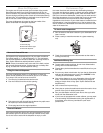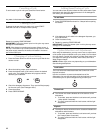
18
■ Silica film or etching (silica film is a milky, rainbow-
colored deposit; etching is a cloudy film)
Sometimes there is a water/chemical reaction with certain
types of glassware. This is usually caused by some
combination of soft or softened water, alkaline washing
solutions, insufficient rinsing, overloading the drawer, and the
heat of drying. It might not be possible to avoid the problem,
except by hand washing.
To slow this process use a minimum amount of powdered
detergent but not less than 1 tsp (5 mL) per load. Use a liquid
rinse aid and underload the drawer to allow thorough rinsing.
Silica film and etching are permanent and cannot be
removed.
■ White spots on cookware with nonstick finish
Has the dishwasher detergent removed cookware
seasoning? Reseason cookware after washing in the drawer.
■ Brown stains on dishes and drawer interior
Does your water have high iron content? Rewash dishes
using 1-3 tsp (5-15 mL) of citric acid crystals added to the
detergent dispenser main wash section. Do not use
detergent. Follow with a Normal wash cycle with detergent. If
treatment is needed more often than every other month, the
installation of an iron removal unit is recommended.
■ Black or gray marks on dishes
Are aluminum items rubbing dishes during washing?
Disposable aluminum items can break down in the
dishwasher and cause marking. Hand wash these items.
Remove aluminum markings by using a mild abrasive cleaner.
■ Orange stains on plastic dishes or dishwasher interior
Are large amounts of tomato-based foods on dishes placed
in the dishwasher? It may be necessary to use a stain
removal product to remove stains from your dishwasher.
Stains will not affect dishwasher performance.
Dishes do not dry completely
■ Dishes are not dry
Did you load your drawer to allow proper water drainage? Do
not overload. Refer to the “Dishwasher Loading” section. Use
a liquid rinse aid to speed drying. You may need to adjust the
Rinse Aid setting. (See “Option Selections and Adjustments.”)
Are the plastics wet? Plastics often need towel drying.
Is the rinse aid dispenser empty? Refer to the “Rinse Aid
Dispenser” section.
Dishes are damaged during a cycle
■ Chipping of dishes
Did you load the dishwasher properly? Load the dishes and
glasses so they are stable and do not strike together from
washing action.
NOTE: Antiques, feather-edged crystal, and similar types of
china and glassware might be too delicate for automatic
dishwashing. Wash by hand.
Excessive pump noise
■ Are the filter plate and/or spray arm correctly placed?
■ Is there water in the pump area? It is normal during first use
or after the dishwasher has not been used for long periods of
time. Run the drawer through a wash cycle.
Water leaking
■ Is the drain hose disconnected from a waste pipe?
Reconnect the drain hose to the waste pipe.
■ Is the supply inlet hose correctly connected? Make sure that
the inlet hose is connected securely.
■ Are there other leaks? Turn off water and power supplies to
the dishwasher. Contact an authorized service agent. (See
“Assistance or Service.”)
Dishwasher will not open
■ Is the Keylock option selected? Turn Lock off. Hold down the
Lock button until the green light disappears and/or press the
Power button to open the drawer. Refer to “Option Selections
and Adjustments.”
Intermittent beeping
■ The dishwasher is in a pause mode. Close the drawer and
press the Start/Resume button.
Continuous beeping
■ A failure has occurred. (See “Error Codes.”)


















